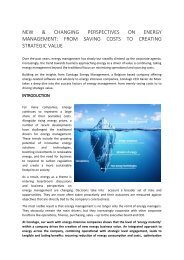Accurate Allocation of energy in production processes - the importance of using metamodels
Many companies struggle with correctly monitoring, allocating and distributing direct and indirect energy consumption over all internal and external customers, users or products. In this age of rising commodity costs and additional attention to sustainability, the advantages of adequately allocating energy are nonetheless substantial: 1. Real-time mapping of energy throughout process flows makes it easier to detect deviations in energy conversions during production processes, find the root causes and reduce losses. 2. Using exact and objective keys for allocating energy consumption speeds up periodic P&L and CSR reporting and makes for more accurate reports. 3. Continuous, real-time distribution of energy cost among users increases transparency and raises awareness with them. Although most companies already struggle with integrating correct data from metered equipment, this is only the first - albeit important - step. The crux is fully understanding the nature and efficiency of energy conversions processes; energy inflows and outflows to different customers; fixed and variable costs and corporate structures. By using metamodels - designed for and maintained by energy managers - all this information is added to the initial metered data and processed in such a way that any change from an energy point of view instantly leads to adjustments in the energy allocation. This white paper reviews emerging trends and challenges in energy allocation and examines the working and benefits of using specific metamodels at the level of energy management software.
Many companies struggle with correctly monitoring, allocating and distributing
direct and indirect energy consumption over all internal and external customers,
users or products. In this age of rising commodity costs and additional
attention to sustainability, the advantages of adequately allocating energy are
nonetheless substantial:
1. Real-time mapping of energy throughout process flows makes it easier
to detect deviations in energy conversions during production processes,
find the root causes and reduce losses.
2. Using exact and objective keys for allocating energy consumption
speeds up periodic P&L and CSR reporting and makes for more accurate
reports.
3. Continuous, real-time distribution of energy cost among users increases
transparency and raises awareness with them.
Although most companies already struggle with integrating correct data from
metered equipment, this is only the first - albeit important - step. The crux is
fully understanding the nature and efficiency of energy conversions processes;
energy inflows and outflows to different customers; fixed and variable costs
and corporate structures. By using metamodels - designed for and maintained
by energy managers - all this information is added to the initial metered data
and processed in such a way that any change from an energy point of view
instantly leads to adjustments in the energy allocation.
This white paper reviews emerging trends and challenges in energy allocation
and examines the working and benefits of using specific metamodels at the
level of energy management software.
Create successful ePaper yourself
Turn your PDF publications into a flip-book with our unique Google optimized e-Paper software.
Not all companies have <strong>the</strong> same needs <strong>in</strong> terms <strong>energy</strong> management s<strong>of</strong>tware.<br />
The key question is how complex <strong>the</strong> relationship between measured <strong>energy</strong><br />
data, <strong>the</strong> process flow and <strong>the</strong> company structure, really is. This will determ<strong>in</strong>e<br />
how difficult it is to map process flows, detect deviations or allocate <strong>energy</strong><br />
consumption to specific users, products or batches.<br />
The guidel<strong>in</strong>es below will help you select <strong>the</strong> right k<strong>in</strong>d <strong>of</strong> s<strong>of</strong>tware.<br />
Do I need a graph-based metamodel <strong>in</strong> my<br />
<strong>energy</strong> management s<strong>of</strong>tware?<br />
When your company is only acquir<strong>in</strong>g commodities like natural gas, water and<br />
electricity and it is not convert<strong>in</strong>g those <strong>in</strong>to o<strong>the</strong>r commodities locally, a graphbased<br />
model is not strictly necessary. S<strong>of</strong>tware us<strong>in</strong>g traditional hierarchical<br />
<strong>metamodels</strong> can suffice. However, if you want to do cost allocation with <strong>the</strong><br />
<strong>energy</strong> management s<strong>of</strong>tware a graph based model can ease <strong>the</strong> setup <strong>of</strong> such<br />
an application.<br />
For example <strong>in</strong> <strong>the</strong> model <strong>in</strong> figure 3, <strong>the</strong>re are two conversion nodes: one CHP<br />
and one hot water. This company would def<strong>in</strong>itely pr<strong>of</strong>it from a graph based<br />
metamodel <strong>in</strong> <strong>the</strong>ir <strong>energy</strong> s<strong>of</strong>tware.<br />
Do I need a versioned metamodel <strong>in</strong> my<br />
<strong>energy</strong> management s<strong>of</strong>tware?<br />
Depend<strong>in</strong>g on <strong>the</strong> dynamics <strong>of</strong> your company, you may or may not need a<br />
versioned metamodel. Suppose <strong>the</strong> largest time frame on which you report is<br />
one year and <strong>the</strong> company structure - <strong>in</strong>clud<strong>in</strong>g sites, build<strong>in</strong>gs and product<br />
l<strong>in</strong>es - is stable with<strong>in</strong> <strong>the</strong> year, <strong>the</strong>n no versioned model is needed.<br />
If your company, however, launches two new products and builds two new<br />
product l<strong>in</strong>es dur<strong>in</strong>g <strong>the</strong> year, <strong>the</strong>n a versioned model with three versions may<br />
be needed to report accurately over <strong>the</strong> year. The first version describes <strong>the</strong><br />
start <strong>of</strong> year situation. The second version <strong>the</strong> new situation after <strong>the</strong> open<strong>in</strong>g<br />
<strong>of</strong> <strong>the</strong> first new product l<strong>in</strong>e. F<strong>in</strong>ally, <strong>the</strong> third version is needed after <strong>the</strong><br />
open<strong>in</strong>g <strong>of</strong> <strong>the</strong> second new product l<strong>in</strong>e. The year report<strong>in</strong>g period will need to<br />
be partitioned <strong>in</strong>to three partitions where each version is valid. After report<strong>in</strong>g<br />
on each partition, <strong>the</strong> f<strong>in</strong>al report will present <strong>the</strong> aggregation <strong>of</strong> <strong>the</strong> three<br />
partitions. When only <strong>the</strong> latest version is available <strong>in</strong> <strong>the</strong> s<strong>of</strong>tware <strong>in</strong> case <strong>of</strong> a<br />
non-versioned metamodel, <strong>the</strong>n no accurate report can be generated over <strong>the</strong><br />
year.<br />
25




